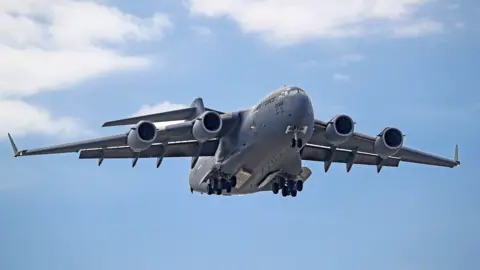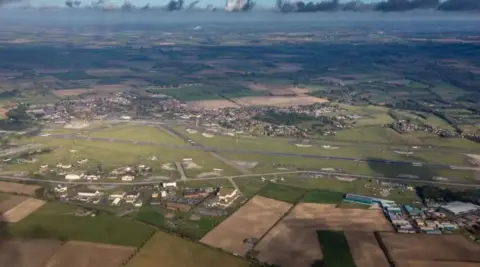Military plane narrowly avoided glider collision
 Getty Images
Getty ImagesAn RAF transport plane and privately operated glider narrowly avoided crashing into each other during an "extremely close encounter", investigators said.
The near-miss occurred above Bury St Edmunds in Suffolk as a Boeing C-17 Globemaster III transport plane headed to land at the US Air Force base of RAF Mildenhall on 17 July 2024.
The pilot spotted an ASH 31 glider ahead of its position before "rapidly disconnecting the autopilot" and performing a hard left turn to avoid a mid-air crash at about 15:30 BST.
The UK Airprox Board concluded there had been a "serious risk of collision" as the aircraft came within 500ft (150m) of each other, assessing it as Category A - the highest possible risk.
 Getty Images
Getty ImagesC-17s are used by the Royal Air Force and the United States Air Force and have a maximum take off weight of 265,350kg (585,000lb).
ASH 31 gliders are single seat aircraft with a wingspan of either 18m or 21m and a maximum take off weight of 700 kg (1,543 lb).
During the investigation it was established the glider pilot had switched off their transponder in order to save battery, having been airborne for over six hours.
However, in doing so, neither the pilot of the C-17 nor air traffic control at Lakenheath were able identify the glider was flying within the same airspace.
This, coupled with the glider having "incompatible" electronic equipment, also meant the ASH 31 pilot could not detect the C-17 ahead of time.
Investigators ruled this had "limited the effectiveness of recognised barriers to mid-air collision" in what is "one of the busiest military airfields" in the UK.
They did, however, acknowledge the glider pilot "had done all possible" to avoid the collision upon seeing the C-17.
The pilot of the C-17 reported the glider had been just 500ft (150m) away at the time of the late sighting.
It was ruled that both pilots "shared an equal responsibility for collision avoidance and not to operate in such proximity to other aircraft".
The UK Airprox Board said that while both pilots had been able to take late avoiding action, the incident had seen "safety reduced to the bare minimum".
Follow Suffolk news on BBC Sounds, Facebook, Instagram and X.
